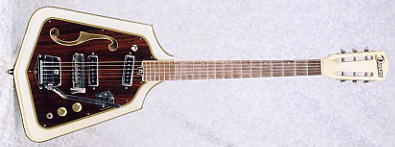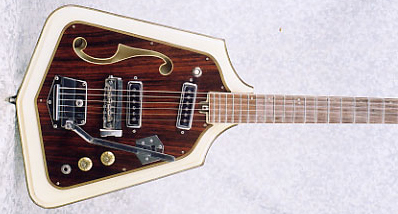And we’ll have fun, fun, fun ’till daddy takes the T-bird away. The beach. The sun. California has flirted with national popularity ever since the Gold Rush. And when filmmakers discovered the endless summer of Hollywood, its ascent to national dominance as a symbol became assured. But it really wasn’t until the 1960s that California became the center of the youth-culture universe. From the Beach Boys to the Doors, California was where it was at. So, when the Maurice Lipsky Music Co., a prominent importer and distributor in New York City, wanted to name the more adventuresome parts of his Japanese-made Domino line, creating an association with the Left Coast seemed natural.

Vintage 1960's Domino Californian Rebel Electric Guitar
Lipsky, by the way, was the company that offered the Orpheum brand of guitars at least from the 1950s on, if not earlier. Many Orpheum’s were made by United Guitars of Jersey City, NJ, the successor to the Oscar Schmidt Company. United also built most of the Premier guitars sold by the Peter Sorkin Music Co. There is some evidence that Lipsky’s Orpheum name was used on some Italian Wandré guitars, as well.
In 1967 Lipsky introduced a line proto-copies carrying the Domino brand name. Most were inspired by European models such as the EKO Violin guitar. Among the offerings were two models sporting a California cache, the #502 Californian, an asymmetrical copy of a Vox Phantom, and the #CE82 Californian Rebel (wouldn’t California Rebel have made more sense?) shown here. As far as I’m aware, the Californian Rebel was like no other guitar available at the time. I suppose you’d call this a semi-solid, since most of it is solid, but built in halves with a sound cavity routed out under the one sound hole. The top has a nice German carve relief, which makes the painted-on “binding” kind of amusing! The slotted head adds a kind of retro vibe. Note the cool dots along the top side of the bound fingerboard. What looks like a rosewood pickguard is wood grained plastic. Like a lot of mid-’60s guitars, the vibrato has a flip-up mute, basically a spring-loaded bar with a piece of foam rubber that deadens the strings. Kind of neat, but it’s hard to imagine how anyone would use it.

Vintage 1960's Domino Californian Rebel Electric Guitar
With these big chunky pickups you get a 50-50 chance on having good sound, or maybe much better than that. Most are pretty high output for a single-coil. I once bought a bag of these and found pickups ranging from 5K to a whopping 13K resistance (a hot Humbucker runs around 8.5K)! To make these even cooler, the two sliding switches are attached to different value capacitors to give you more tonal variety.

Vintage 1960's Domino Californian Rebel Electric Guitar
Who actually built this guitar is unknown, but these pickups appear to be associated with Kawai guitars, and that’s probably a good guess.
Alas, the 1960s were closer to the heavy, meandering solos of the Doors than the strum-a-lum twang of the Beach Boys when this guitar appeared. Besides, the guitar boom of earlier in the decade was grinding rapidly to a halt. 1966 was the peak year of guitar imports, with a dramatic decline in ’67. In 1968 Valco/Kay and a bunch of Japanese makers went out of business. Maurice Lipsky drops from sight around this time, and the industry went through a period of transition which yielded the Copy Era of the 1970s. Still, the Domino Californian Rebel is a very boss guitar, perfect for picking Pipeline on the beach at sunset.

I own two Californian Rebels, and just played one for a live gig last week in my surf band! They’re pretty unbelievable- they feel and sound great, and are just fun to look at. Hard to find too!
I have an old californian rebal by domino that i want to sell. it would need to be gone through. Anybody interested? drop a message at gregnmandy99@bellsouth.net
Darren, would you consider selling one of your Californian Rebels? I’ve been after one for ages! Drop me an e-mail on corey.bowen@hotmail.co.uk
Sorry everyone, I have sold my Californian rebel. Thanks for all the interest.
I read another article on this website saying that you own a couple of domino californians, I was just wondering if you are interested in selling one of these guitars????
Yes, make a “Domino”…and send me the prototype…I will promote it!
I want one!
I’m not a fan of the headstock, but the rest of the guitar looks interesting – a more angular take on the “Breadwinner” concept. Ought to be comfortable to play, and if Eastwood does its usual updating of electronics, this could be really cool.
If anyone has a californian rebel they want to sell send me a message at keithdhoo@gmail.com
Hey. If someone sells a Californian Rebel please contact me : seppe89@yahoo.de
I want this guitar so much!
Thank You!
I have a 60’s model Domino six string , looks like a Vox type body has 3 pickup’s ,4 switches and a volume and tone knob, by the bridge is a (string muff) that mutes the strings and a whammy bar.(handle missing)
It is white with a wood grain pick guard and maple neck .No Case!
I would like to sell it, ( $500.00) plus shipping, if anyone is interested contact me for pic’s.
If you still have a Domino Californian Rebel I’d be very interested, thanks!
Hey,
If you have a Californian Rebel I am interested to buy from you!
Contact me – vhabdelnur@hotmail.com
Thanks!